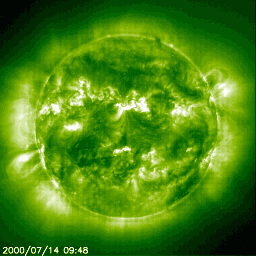Intense Flare and Halo CME -- 14 July 2000
 |
 |
| This solar flare recorded by the ESA/NASA Solar and Heliospheric Observatory (SOHO) had been predicted to erupt from the large sunspot group 9077. It turned out the be one of the largest such events of the current solar cycle. It was recorded by the spacecraft's Extreme-ultraviolet Imaging Telescope (EIT) at 195 angstroms. Relativistic energetic protons, travelling at a significant fraction of the speed of light bombarded this detector about 15 minutes after the flare. | The halo coronal mass ejection which followed
was recorded by SOHO's C2 coronograph.
The speckles which appear late in the sequence also result from
very energetic particles. Travelling at 5--15% of the speed of
light, these particles arrived within a couple of hours of the
flare event resulting in the speckling seen.
The central disk blocks out the Sun's bright light; the white circle near the center shows the true size of the Sun. |
| The resulting interplanetary shock hit the Earth at 15:00 UT (08:00 PDT), producing aurorae spotted as far south as 40 degrees latitude in Asia, Europe and eastern North America. Southern hemisphere observers in Australia and New Zealand were able to see the `southern lights'. | |
Mark Wilber Last modified: Tue May 16 10:03:09 PDT 2000